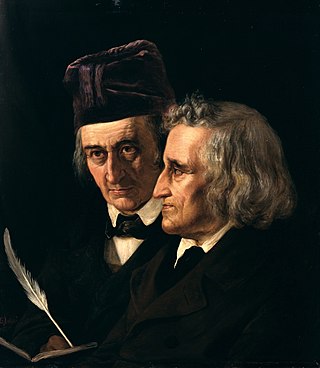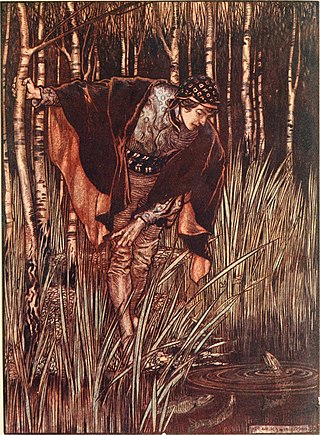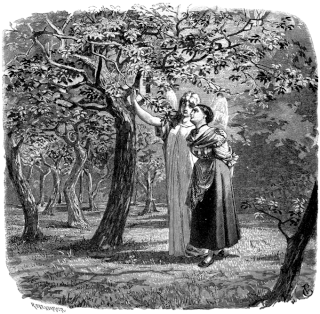Related Research Articles

The Brothers Grimm, Jacob (1785–1863) and Wilhelm (1786–1859), were German academics who together collected and published folklore. The brothers are among the best-known storytellers of folktales, popularizing stories such as "Cinderella", "The Frog Prince", "Hansel and Gretel", "Town Musicians of Bremen", "Little Red Riding Hood", "Rapunzel", "Rumpelstiltskin", "Sleeping Beauty", and "Snow White". Their first collection of folktales, Children's and Household Tales, began publication in 1812.

Dorothea Viehmann was a German storyteller. Her stories were an important source for the fairy tales collected by the Brothers Grimm. Most of Dorothea Viehmann's tales were published in the second volume of Grimms' Fairy Tales.

Grimms' Fairy Tales, originally known as the Children's and Household Tales, is a German collection of fairy tales by the Brothers Grimm, Jacob and Wilhelm, first published on 20 December 1812. Vol. 1 of the first edition contained 86 stories, which were followed by 70 more tales, numbered consecutively, in the 1st edition, Vol. 2, in 1815. By the seventh edition in 1857, the corpus of tales had expanded to 200 tales and 10 "Children's Legends". It is listed by UNESCO in its Memory of the World Registry.

"The White Snake" is a German fairy tale collected by the Brothers Grimm and published in Grimm's Fairy Tales. It is of Aarne–Thompson type 673, and includes an episode of type 554.

"Bearskin" is a fairy tale collected by the Brothers Grimm. A variant from Sicily, "Don Giovanni de la Fortuna", was collected by Laura Gonzenbach in Sicilianische Märchen and included by Andrew Lang in The Pink Fairy Book. Italo Calvino included another Italian version, "The Devil's Breeches" from Bologna, in his Italian Folktales.

"The Devil and his Grandmother" or "The Dragon and His Grandmother" is a German fairy tale collected by the Brothers Grimm, number 125. According to Jack Zipes, the source of the story was Dorothea Viehmann, the wife of a tailor from Hesse.

"The Girl Without Hands" or "The helpless Maiden" or "The Armless Maiden" is a German fairy tale collected by the Brothers Grimm. It is tale number 31 and was first published in the 1812 edition of Children's and Household Tales. The story was revised by the Grimm brothers over the years, and the final version was published in the 7th edition of Children's and Household Tales in 1857. It is Aarne-Thompson type 706.
"Thumbling," published in German as "Daumesdick" is a German fairy tale collected by the Brothers Grimm in Grimm's Fairy Tales in 1819. The Grimms included another, similar story, "Thumbling's Travels." Both stories are related to the English Tom Thumb and often share its title when translated into English.

"The Peasant's Wise Daughter", "The Peasant's Clever Daughter" or "The Clever Lass" is a German fairy tale collected by the Brothers Grimm in Grimm's Fairy Tales as tale number 94. It has also spread into Bohemia and Božena Němcová included it into her collection of Czech national folk tales in 1846.
"The Griffin" is a German fairy tale collected by the Brothers Grimm in Grimm's Fairy Tales.
"The Three Apprentices" or "The Three Journeymen" is a German fairy tale collected by the Brothers Grimm in Grimm's Fairy Tales as tale number 120.
"The Turnip" is a German fairy tale collected by the Brothers Grimm in Grimm's Fairy Tales.

"The Old Man and his Grandson" is a German fairy tale collected by the Brothers Grimm in Grimm's Fairy Tales as tale number 78.

"The Wedding of Mrs. Fox" is two German fairy tales collected under the same title by the Brothers Grimm in Grimm's Fairy Tales as number 38. It was included in all editions, and is classified as Aarne-Thompson type 65, 1350, 1352*, and 1510.
"Frederick and Catherine" is a German fairy tale collected by the Brothers Grimm in Grimm's Fairy Tales, number 59.
"The Little Peasant" is a German fairy tale collected by the Brothers Grimm in Grimm's Fairy Tales, number 61.
"The Peasant in Heaven" is a German fairy tale collected by the Brothers Grimm in Grimm's Fairy Tales, number 167.

The German Fairy Tale Route is a tourist attraction in Germany originally established in 1975. With a length of 600 kilometres (370 mi), the route runs from Hanau in central Germany to Bremen in the north. Tourist attractions along the route are focused around the brothers Wilhelm and Jacob Grimm, including locations where they lived and worked at various stages in their life, as well as regions which are linked to the fairy tales found in the Grimm collection, such as The Town Musicians of Bremen. The Verein Deutsche Märchenstraße society, headquartered in the city of Kassel, is responsible for the route, which travellers can recognize with the help of road signs depicting the heart-shaped body and head of a pretty, princess-like creature.

"The Grave Mound" is a German fairy tale collected by the Brothers Grimm, KHM 195. It is Aarne-Thompson type 779, Divine Rewards and Punishments.

"The Good Bargain" is a German fairy tale collected by the Brothers Grimm, KHM 7. This antisemitic fairytale was added to the Grimms' collection Kinder- und Hausmärchen with the second edition of 1819. It is a tale of Aarne–Thompson type 1642. A similar anti-Semitic tale collected by the Grimms' is The Jew Among Thorns.
References
- ↑ Jacob and Wilheim Grimm, Household Tales, "The Peasant and the Devil" Archived 2014-07-03 at the Wayback Machine
- ↑ D.L. Ashliman, "The Grimm Brothers' Children's and Household Tales (Grimms' Fairy Tales)"